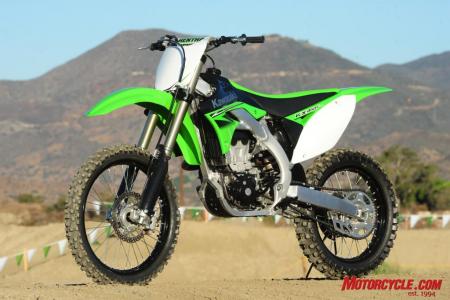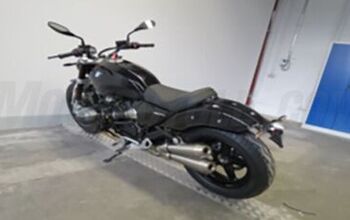2010 Kawasaki KX450F Review - Motorcycle.com
Word has been floating around the motocross world that Kawasaki’s new fuel-injected 450 was going to turn the sport on its ear, with power, handling and technology superior to anything yet seen in the industry. True, the new KX450 “works” bikes have been tallying up wins across the country, under the steady hands of Hahn, Dietrich, and Villopoto, but what does that mean for the redesigned 2010 production KX450F?
Will it share technology with the works bikes? Will it be a better machine in every way? Motorcycle.com got invited by Kawasaki to preview their latest weapon in the MX wars, and we showed up anticipating wonderful things.
Kawasaki hosted this event at the newly opened Pala Raceway, on the Pala Indian reservation in Southern California. At a press intro, usually you get bikes that have been broken in, cleaned up with new plastic and tires, so the testers get machines with the “bugs” worked out of them. Not this time, all the bikes were new, with zero hours on them.
There were three mechanics assigned to each magazine crew: two Kawasaki techs and one Kayaba man. We even had a tire guy from Bridgestone to inspect the wear our rider was putting on the Bridgestone 404s front and back, and it proved to be an excellent motocross tire for the sun-baked clay that makes up a SoCal MX track.
Our test rider, Joey Webb, was pirated from Noleen Racing and was the fastest guy on the track, hands down. He was so smooth it was like watching a young Roger DeCoster carve up the course. Joey Webb is going to be a big name in motocross some day, you can bet on that. And he’s ours (when he’s not slaving away in the Noleen shop rebuilding shock absorbers, that is).
Now the young Mr. Webb had never ridden a 450 Kawasaki before, and as such had no preconceived notions on the bike.
Based on some of the issues known about the earlier KX450Fs, here are some of the things I asked Joey to do with the big KX:
“Abuse the clutch; see if you can make it go away. Go a gear higher into turns, see how it pulls out. Abuse the transmission, and try to make the front end plow off the berms. Also work the brakes hard and try to make them fade, also, lug the motor down in too high a gear, and go real slow, see if those big radiators do their job.”
After getting his battle orders, here are Joey’s initial impressions of the new KX450F:
“The bike has power. No, make that power. It has a good amount of low-end and a massive midrange hit. Top-end pull was excellent.”
Kawasaki has improved the power over earlier versions of the 450, in part by the addition of electronic fuel injection with new 12-hole injector set at a 45-degree angle to improve combustion efficiency.
Engineers also concentrated on reducing the engine’s reciprocating mass with the introduction of a new “bridge box” piston type that is seven grams lighter than previous effort and the use of aluminum valve-spring retainers. The exhaust’s head pipe has been shortened by 40mm, and camshafts have been lightened and given a soft-nitride coating to improve durability. The airbox has improved breathing, along with revised mapping for the engine control module. So it looks like Joey was correct in his assessment of the new 450’s power.
The KX’s transmission proved to be notchy, especially in the lower gears. Kawasaki said it would loosen up with time, but some Kawasaki dirt bikes have had had the issue of having a strong but notchy transmission. Also, first gear is very tall, like a cross between first and second gears. Kawasaki doesn’t list any changes in the 2010 KX450F’s transmission except for a beefier clutch and clutch hub. The mechanics relayed that the transmission would loosen up after a few hours of break-in time, but we couldn’t verify this in our short test.
The big KX’s 48mm inverted fork was harsh on the initial stroke, so the Kayaba guy diddled with the settings and got it to work better but not perfect. This might be attributed to a lack of setup or simply time for the
For 2010 the Kayaba fork has undergone damping and spring rate changes in an effort to ease up on the initial stroke. The sliders have been given a Diamond-like Coating (DLC) to reduce stiction and protect the sliders from damage. Again, the Kayaba reps relayed that the forks require at least 3-4 hours of break-in before they start working as designed.
The 450’s engine bogged off a few tabletops when going at it a gear higher and sometimes did a big backfire...POP! The mechanics had no explanation for this and cited a nominal break-in time as the culprit. Only a few of the bikes tested had this phenomenon.
Our tester got the front brake to fade when he really hammered it, though it might’ve been a set-up issue with this bike, as none of the other testers reported this problem. The rear brake worked without much drama.
Kawasaki jiggered with the handlebar mounts on this new KX, now being off-set by 2mm in the top triple clamps compared to last year’s version. Joey said the steering was very precise and demanded a lot of concentration. “I tried to get the front end plow by doing stupid stuff, like going full-lock into a soft berm, but it stuck, no washout.” Webb reported a light-feeling front end that takes some acclimatization.
Ergonomically, string-bean Joey had no complaints, except for the radiator shroud hooking his knee brace on the throttle side, although this may have been caused by his particular riding gear.
Our test monkey reported the KX is very stable in the air, adding that he had to keep his weight more forward than on his YZ. Again, the front end seemed on the light side. Landings nose up or nose down were handled with aplomb, with the revised frame geometry and less rigid steering stem being major factors here.
The rear shock linkage is designed to supply a more compliant initial take-up, and Joey didn’t mention any problems with the rear suspension after the shock’s preload was reduced to match his weight. The Kayaba damper is adjustable for both compression (both high- and low-speed) and rebound damping, and JW was happy with its performance.
The 450 is a one-two kickstarter. It’s so easy it looks like you’re starting a 100cc bike. “This is the easiest starting big-bore four-stroke I ever rode,” says Webb. The fuel injection has more than a lot to do with it. Many times in 2008 when James Stewart would crash or drop his carbureted KX450, it would take a dozen or more kicks to get it fired up. This fuel inject is not a gimmick, but a real needed item. We asked the mechanics if there was any other things done to the motor to make it start so easy, and they said “nope.” Can’t argue with that.
Joey worked the KX hard all day, doing a few back-to-back 30-minute motos, with the rest of the day spent trying to make the bike fail or under-perform in the areas we discussed.
Later in the day when the temperature over 100 stinking-hot degrees, Joey came in for some water and I asked him point blank which bike was better, his YZ or the new KX. He didn’t reply, but the smile on his face said it all. He quickly guzzled down the water, and headed back out for a few more laps. I could tell he was impressed with the KX.
While Joey was roosting around the new Pala MX track, I got the chance to corner the two mechanics assigned to the Motorcycle.com team and ask some questions about the new 450. I got the impression that Kawasaki was trying to design the new KX to be more user-friendly maintenance-wise. That notion was completely wrong, as the conversation went something like this:
Me: I see you’ve added more weight to the engine’s lower end, carburized the connecting rod, redesigned the oiling system and the valve assembly. Is this an effort to make TBO (time between overhauls) a little longer?
Mechanic: “No, this is a full-on race machine, and we’re not giving anything up performance-wise versus wear on the motor. If anything, with the amount of power this 450 is putting out, maintenance will come sooner than with the previous design. I’d say 16-18 hours before we do a leak-down. After all, this bike is putting out around 52-55 horsepower and is smoking fast.”
Me: Uh…OK…duh…
To illustrate the “works” quality of components in the KX450F, Kawasaki set up a table showing the top-end parts and radiators, along with the clutch hub and plates, from the ’09 to the ’10 model. The radiators are a lot bigger, with larger top and bottom tanks and more surface area. And the clutch plates were beefed up along with the hub.
The new piston looks like an ashtray, a very expensive one at that. I picked it up, and it weighed about as much as a small bag of peanuts. The new “bridged box” piston uses two rings (one compression and one oil control) and has strengthening ribs radiating from the wrist-pin boss. It is only about one inch in length. Trick stuff for sure.
By two o’clock things were winding down at the track, and the other magazines had started hauling away their KX450s for extended testing. I got a chance to finally relax and swill as much water as possible (it was around 105 degrees). I finally got Joey off the bike to get his final impression of the new KX450F.
“Even with the few small issues I had with the KX, I could win with it, given time for break-in and proper set up. It would be a top contender. And it’s faster than my YZ.”
That about sums it up. It looks like Kawasaki has a corrected all the problems that haunted its previous 450s and made a deadly serious bike. This is not a toy; this is a hardcore professional racing machine.
If you approach it in any other fashion and try to treat it as a trail bike or play bike, you will be sorely disappointed. If you buy it to win races, it will deliver.
More by Matt Cuddy









































Comments
Join the conversation